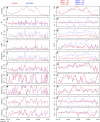A suite of global, cross-scale topographic variables for environmental and biodiversity modeling
- PMID: 29557978
- PMCID: PMC5859920
- DOI: 10.1038/sdata.2018.40
A suite of global, cross-scale topographic variables for environmental and biodiversity modeling
Abstract
Topographic variation underpins a myriad of patterns and processes in hydrology, climatology, geography and ecology and is key to understanding the variation of life on the planet. A fully standardized and global multivariate product of different terrain features has the potential to support many large-scale research applications, however to date, such datasets are unavailable. Here we used the digital elevation model products of global 250 m GMTED2010 and near-global 90 m SRTM4.1dev to derive a suite of topographic variables: elevation, slope, aspect, eastness, northness, roughness, terrain roughness index, topographic position index, vector ruggedness measure, profile/tangential curvature, first/second order partial derivative, and 10 geomorphological landform classes. We aggregated each variable to 1, 5, 10, 50 and 100 km spatial grains using several aggregation approaches. While a cross-correlation underlines the high similarity of many variables, a more detailed view in four mountain regions reveals local differences, as well as scale variations in the aggregated variables at different spatial grains. All newly-developed variables are available for download at Data Citation 1 and for download and visualization at http://www.earthenv.org/topography.
Conflict of interest statement
The authors declare no competing financial interests.
Figures








References
Data Citations
-
- Amatulli G., et al. . 2017. PANGAEA. https://doi.org/10.1594/PANGAEA.867115 - DOI
References
-
- Stein A. & Kreft H. Terminology and quantification of environmental heterogeneity in species-richness research. Biological Reviews 90, 815–836 (2015). - PubMed
-
- Moore I. D., Grayson R. B. & Ladson A. R. Digital terrain modelling: a review of hydrological, geomorphological, and biological applications. Hydrological processes 5, 3–30 (1991).
-
- Elith J. & Leathwick J. R. Species distribution models: ecological explanation and prediction across space and time. Annual Review of Ecology, Evolution, and Systematics 40, 677 (2009).
-
- Guisan A. & Thuiller W. Predicting species distribution: offering more than simple habitat models. Ecology letters 8, 993–1009 (2005). - PubMed
-
- Alexander C., Deák B. & Heilmeier H. Micro-topography driven vegetation patterns in open mosaic landscapes. Ecological Indicators 60, 906–920 (2016).
Publication types
LinkOut - more resources
Full Text Sources
Other Literature Sources

